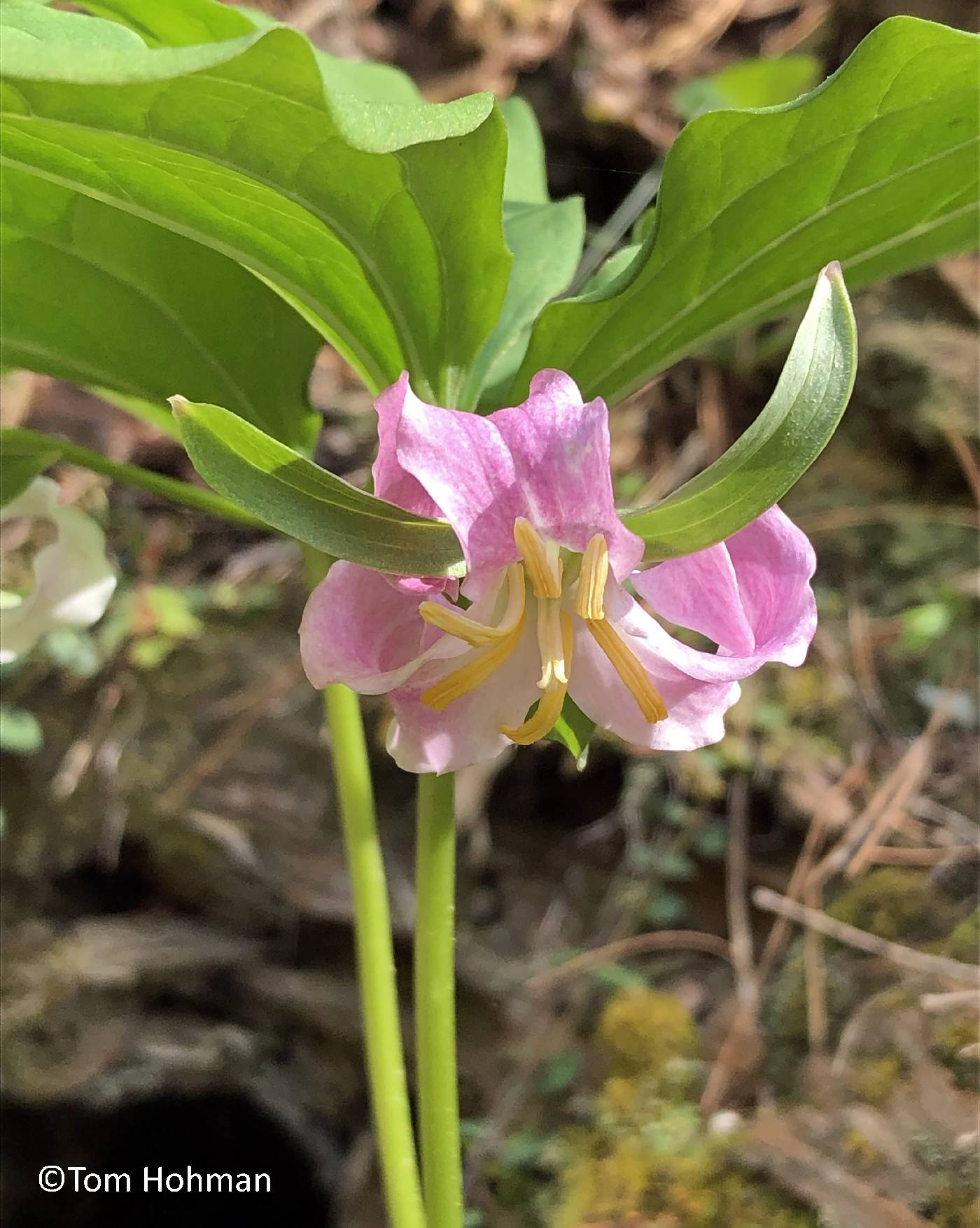Trillium
|
Family: Melanthiaceae |
Herbs, perennial, scapose, rhizomatous; rhizomes subterranean, horizontal or semierect, monopodial, unbranched or weakly branched, elongated to thick and fleshy, compressed-shortened, distal end tapered to point or praemorse, apex bearing large terminal bud, numerous cataphylls, and contractile, adventitious, ringed roots. Scapes arising from terminal bud or axil of adjacent cataphylls, aerial (subterranean in T. petiolatum), erect, straight (decumbent, S-shaped in T. decumbens and T. reliquum). Bracts on mature plants in whorl of 3, uniformly green or mottled, foliaceous, petiolate or sessile, venation palmate-reticulate, with 3-5 major veins, ovate or obovate to elliptical. Inflorescences terminal, 1-flowered. Flowers: some totally to partially syncarpous, pedicellate or sessile; sepals persistent, 3, distinct, green, maroon, or with maroon markings, foliaceous, oblong, ovate, or lanceolate, alternating with bracts; petals shriveling after anthesis, typically 3, erect, spreading, or recurved, distinct, red, purple, pink, white, yellow, green, or combination of these, ovate or obovate to linear, sometimes clawed; stamens 6, alternating in 2 whorls of 3, erect, incurved, or divergent; filaments mostly short, basally expanded; anthers 2-locular, ± equaling or longer than filaments, dehiscence extrorse, latrorse, or introrse; connectives flat between (or in some species extending beyond) anther sacs; ovary superior, proximal portion 3-locular, 3- or 6-lobed, some axile, some parietal or a combination of both, distal portion forming stigmas; stigmas often persistent, 3, spreading, twisted, or erect, sometimes connate, sessile or with very short style, linear to subulate. Fruits capsular or baccate, fleshy with obscure sutures, not or rarely dehiscent along sutures, each shed as unit through abscission of thin-walled cells at base. Seeds many, elliptic, 2-4 mm, bearing white or yellowish, large, oily, myrmecochorous elaiosome (aril). x = 5. 2n = 10 in all American species recorded. Trillium is traditionally divided into two subgenera, which overlap in some characters. Botanists consider subg. Trillium to be the more primitive group, because the genera considered closest to Trillium all have pedicellate flowers, as does subg. Trillium, except for one variety of T. pusillum that bears sessile to only barely pedicillate flowers. There is not yet agreement among taxonomists about the relationships among the species within the genus. Certain ones, such as Trillium recurvatum and T. lancifolium, clearly are closely related, but the interrelationships of many others are not obvious. In the absence of definitive studies, the species are listed here alphabetically within subgenera. Several species of Trillium contain sapogenins that have been used medicinally as astringents, coagulants, expectorants, and uterine stimulants, hence the common names birthwort and Indian balm, and T. erectum, T. grandiflorum, and possibly other species have been utilized commercially as beth root (W. B. Zomlefer 1996). Fruits, seeds, and rhizomes of trilliums are generally considered to be poisonous. Deer, however, feed voraciously on T. grandiflorum plants, especially in early spring. Gardeners and wildflower enthusiasts, over most of the temperate zones of the world, consider trilliums to be among the most beautiful of wildflowers. Species of Trillium exhibit few and obscure structural differences, making key construction difficult (J. D. Freeman 1975). The key below, adapted with permission from F. W. Case and R. B. Case (1997), works best with fresh, live material. Many species hybridize, especially within the T. erectum group. Hybrids and the occasional anomalous, odd-sized, or diseased individuals are not keyed here. Morphologically, Trillium plants produce no true leaves or stems above ground. The horizontal rhizome produces dry, scalelike leaves (cataphylls). The above-ground plant is a flowering scape, and technically the leaflike structures are bracts subtending the flower. Origin aside, the bracts function in photosynthesis and have external and internal structure similar to that of a leaf, and many authors refer to them as leaves.
Tep distinct, the sep herbaceous and generally green, the pet white or colored; stamens hypogynous; filaments mostly short; anthers linear, basifixed, sometimes with a prolonged connective; ovary trilocular, 3-lobed or 3- or 6-angled or -winged; style short or none; stigmas 3, ±elongate, usually divergent; fr a many-seeded berry; herbs from a usually short and stout rhizome, the erect stem bearing a single whorl of usually ample, ±net-veined lvs and a single large, terminal fl. Most spp. with white fls produce pink or rarely maroon forms, and spp. with maroon fls likewise have occasional forms with yellow, green, or more rarely white fls. 50, N. Amer. and e. Asia. Spp. 5-8 and 11-13 ±confluent. Gleason, Henry A. & Cronquist, Arthur J. 1991. Manual of vascular plants of northeastern United States and adjacent Canada. lxxv + 910 pp. ©The New York Botanical Garden. All rights reserved. Used by permission. |

